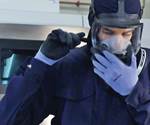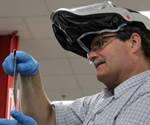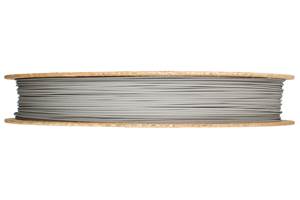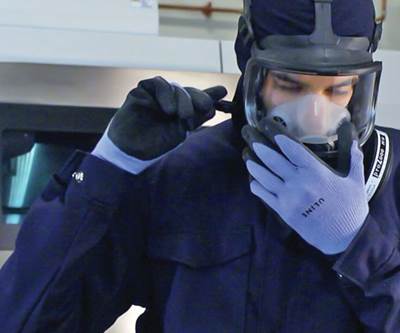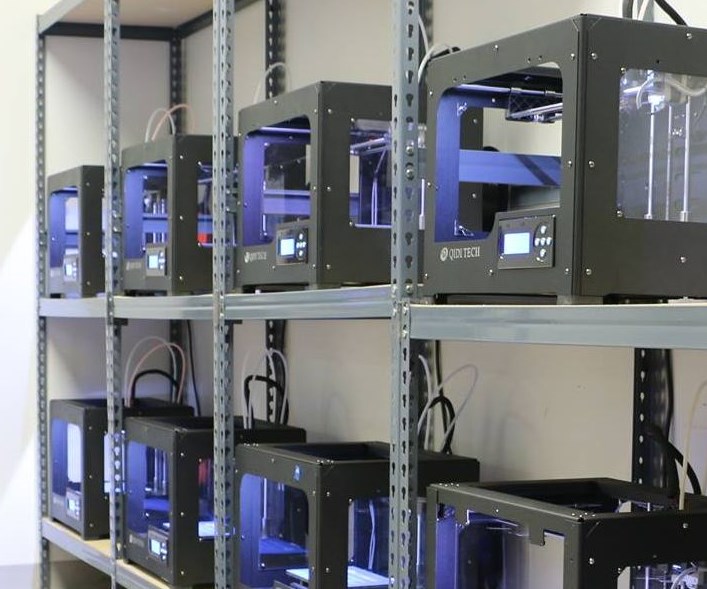
3D printers on open shelves are a common sight, but are they safe? According to NIOSH, FFF 3D printers can emit volatile organic compounds (VOCs) and ultrafine particles. Read on for the organization’s recommendations to protect users from exposure. Photo credits: NIOSH
Fused filament fabrication (FFF) works on the same principle as injection molding: melt plastic and form it into a final shape. It stands to reason that the emissions from a 3D printer, then, might be comparable to those from an injection molding press. But the difference, says Lauren Bowers, researcher at the National Institute for Occupational Safety and Health (NIOSH), is in exposure time.
“With injection molding, you’re putting the melted plastic into a closed mold that is stationary,” she says. Forming the part can take as little as a few seconds, and all the melted material is contained within the mold. “But with 3D printing, melted material is moving in all axes in the build chamber, and a large part could take hours to print. Particles can remain in the air for longer periods of time during printing versus injection molding.”
Even enclosed printers don’t necessarily protect users from these emissions, she notes. Often these enclosures are designed to maintain a constant temperature environment for 3D printing, not necessarily to control the release of potential contaminants. With many FFF printers lacking appropriate filters or enclosures at all, there are opportunities for particulate to escape and cause potential health risks to operators.
According to Aleksandr Stefaniak, industrial hygienist at the Centers for Disease Control and Prevention and Bowers’ colleague, there are two specific stages that filament goes through in the FFF process. First, the melting plastic gives off volatile organic compounds (VOCs) and ultrafine particles (UFPs) that can spread throughout the vicinity around the 3D printer. But as they cool, the VOCs can condense onto these ultrafine particles, which can then be breathed in by nearby humans. These particles can irritate lungs, exacerbate asthma and potentially carry other problematic compounds into the respiratory system.
“These are particles that have diameters usually less than about 100 nanometers,” Stefaniak says. “Sometimes these VOCs can adhere to those particles, and the particles can kind of act as a transporter and bring them deep into the lung, where it’s difficult for them to be cleared by the body. If you’re using a polymer that has an additive such as carbon nanotubes, those particles can then essentially act as vehicles to bring those chemicals into the body.”
Studying 3D Printer Emissions
To better understand the risks posed by FFF 3D printers, NIOSH has evaluated printers both in its own facility and at other sites in cooperation with industry partners. At NIOSH, researchers have access to two different testing chambers, measuring 1 and 13 cubic meters. These chambers are designed to evaluate smaller, desktop models such as the one seen below:

These are controlled environment chambers with HEPA filters to ensure that only emissions from the printer are recorded. NIOSH is able to measure the number of particles, size of the particles, total amount of volatile organic compounds and amounts of specific organic chemicals emitted from a given printer. For larger or more expensive printers, NIOSH works with partners and brings enclosures and similar testing equipment into facilities to gather data.
The goal of this research is not to appraise specific printer models or give a pass/fail rating. Rather, NIOSH takes the data it collects and calculates the printers’ emission rate, being the number of particles released per minute or the total number of organic chemicals released per minute. This information can then be used to model different scenarios.
“It allows us to say, if we have so many printers operating in an office environment, or an industrial environment, with this type of air flow, this is what we think the exposure might be,” Stefaniak explains.
How to Counteract the Risks
How does this research and modeling capability play out for 3D printing users? NIOSH offers a Health Hazard Evaluation (HHE) program that helps individuals and companies assess and mitigate potential 3D printing risks. For common scenarios, a researcher might consult by phone and provide existing documentation to help decision makers. For more complex scenarios, teams of researchers may travel to a facility to conduct on-site particulate monitoring and provide recommendations.
(Interested in an evaluation for your facility? Request an HHE here.)
According to Bowers, there are four levels to the hierarchy of recommended controls. From most to least preferred, they are:
- Avoid the hazard altogether. The best-case scenario is to simply avoid risks in the first place. This could be accomplished by purchasing an enclosed 3D printer with the appropriate exhaust and filtration systems already in place, or choosing to build with low-emission materials such as PLA. Users should also avoid “hacks” to printers like swapping nozzles to achieve a higher extrusion temperature, as higher temperatures allow greater quantities of VOCs to be released.
- Engineer the hazard out of the process. Engineered controls include adding enclosures to 3D printers that don’t have them and installing printers under a fume hood or local exhaust. Fans with carbon and/or HEPA filters can also help trap and remove VOCs and ultrafine particles from the air.
- Implement administrative controls. If the risk can’t be avoided, set up policies to limit personnel exposure to VOCs and particulate. For instance, keep printers in a closed room that staff only enter when necessary to retrieve completed parts or perform printer maintenance.
- Use personal protective equipment (PPE). Operators can wear PPE such as respirators and dust masks to avoid breathing in particulate. This is the least-preferred way of approaching the problem because using PPE effectively involves additional training and fit testing. It also requires due diligence to confirm that the filters and cartridges used in PPE are the correct ones to remove the contaminants at hand.
Pursuing the Best-Case Scenario
Near the end of our conversation I asked Bowers and Stefaniak what an ideal “3D printer farm” setup might look like. The answer, of course, is “It depends,” but they offered an instructive example of a facility evaluated during a HHE analysis.
The company in question had two shelves of open FFF 3D printers in a small room; administrative restrictions were already in place, with operators generally only entering the room to unload parts or refill filament. But with jobs running for hours at a time, often overnight, the buildup of particulate and VOCs could become significant.
“After the printers had been running for 10 hours in this enclosed room, someone would come in at 6 or 7 in the morning and get a big hit of whatever’s in the air,” Stefaniak says.
NIOSH’s recommendation involved building Plexiglas doors and walls around the printer shelves, and integrating a fan equipped with a filter to trap VOCs and particulate, as shown below. “Once they started operating that fan, within just a matter of minutes the particle concentration in the room dropped by more than 99%, and the organic chemical concentration dropped by 68%,” Stefaniak says. “That’s the ideal setup, to have things in a room not accessed by a lot of people where the printers are being ventilated.”

Before: The facility in question had two shelves of desktop 3D printers within a small room. While employees only entered the room when necessary, they were hit with the full buildup of VOCs and ultrafine particles each time they did.
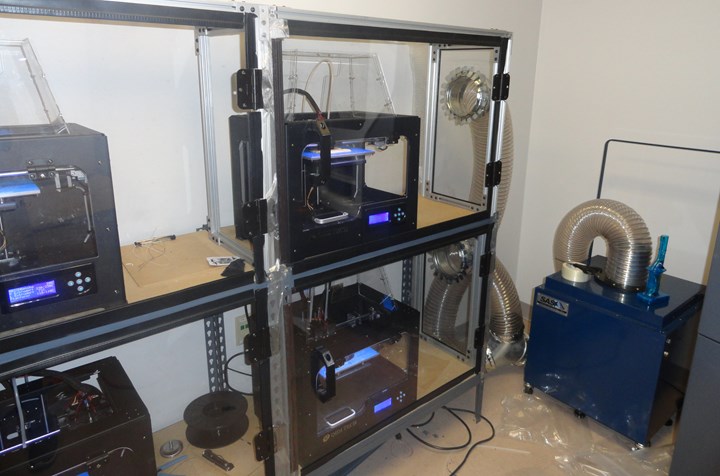
After: Duane Hammond of NIOSH designed, fabricated, installed and tested this custom ventilated enclosure that surrounds all the shelved printers. In this case, the enclosed printers were connected to a fume extractor from Sentry Air Systems (the blue box) which contains an exhaust fan, carbon filter to remove organic chemicals and high-efficiency filter to remove particulate. This setup reduced particle concentration in the room by more than 99% and total organic chemical concentration by almost 70%.
Of course, the printer farm model describes just one way that manufacturers are implementing a specific type of 3D printing technology. NIOSH is at work evaluating other types of printers such as liquid-resin systems using digital light processing (DLP) or stereolithography (SLA). But it’s also interested in what surrounds 3D printing within an additive manufacturing (AM) context.
“3D printing is really just one step in the process,” Stefaniak says. “It’s not always the actual 3D printing that may be the source of exposure. It could be something you do to get the printer ready, or when removing the part, or during postprocessing. We’re trying to break down the process from beginning to end into specific tasks, to understand what’s happening during each one in terms of exposure potential.”
Related Content
Video: 3D Printed Hand Tools in Action on Pella Corporation Factory Tour
Examples include an invention for quickly installing window and door weather stripping, a fitting for giving the proper angle to a nail gun, and a clip for which the color is an important feature.
Read MoreVirtual Foundry’s M300 Tool Steel Filamet Offers Strength, Versatility for FFF 3D Printing
The Virtual Foundry developed its M300 Tool Steel Filamet material for fused filament fabrication, offering compatibility with a variety of 3D printers.
Read MoreUltiMaker Targets Light Industrial Applications With 3D Printer Designed for the Factory Floor
The company’s Factor 4 3D printer introduced this week is designed to complement conventional manufacturing equipment including CNC machining and automation.
Read MoreRaise3D’s Hyper Core Filament Line Offers Increased Heat Conductivity for Rapid Melting and Cooling
Raise3D has also launched its Pro3 HS Series which enables higher speed printing with composite materials to meet demanding engineering and manufacturing needs. The series includes the Pro3 HS, Pro3 HS Plus, Pro3 + HUK3 and Pro3 Plus + HUK3.
Read MoreRead Next
Additive Manufacturing Is Changing the Rules on Safety
Bringing safety to the forefront helps to mitigate the risk of additive technology within a manufacturing environment.
Read MoreSafety Hazards in Additive Manufacturing
The number-one thing a company can do to protect its AM investment and not interrupt production is develop a comprehensive safety policy specifically for additive.
Read MoreBike Manufacturer Uses Additive Manufacturing to Create Lighter, More Complex, Customized Parts
Titanium bike frame manufacturer Hanglun Technology mixes precision casting with 3D printing to create bikes that offer increased speed and reduced turbulence during long-distance rides, offering a smoother, faster and more efficient cycling experience.
Read More

.jpg;width=70;height=70;mode=crop)
